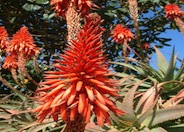
Common name:Prostrate Rosemary
Botanical name:Rosmarinus officinalis 'Prostratus'
The 'Prostratus' grows to a height of 2'-3' with a spread to 8'. Its flowers are pale, lavender blue in color; the leaves are needle-like with a dark, blue-green color. This plant makes a good groundcover, and its leaves can be used as seasoning in cooking.

Common name:Red Mexican Lobelia
Botanical name:Lobelia laxiflora
This Lobelia is a very showy, shrub-like perennial, growing to 2'-4' tall. It spreads by underground rhizomes. It has bright, tubular, orange-red summer flowers with yellow orange throats. It can tolerate low water conditions. Hummingbirds love this Lobelia. It thrives in wet soil but does not require it. This is the most tolerant of Lobelias for full sun sites.

Common name:Tree Aloe
Botanical name:Aloe arborescens
This succulent is large, full of branches and produces deep red orange blooms in fall and winter. The flowers produce a nectar that is attractive to many different birds; this plant is grown all over the world. This succulent can reach 8' tall and 5' wide. Leaves are narrow, recurved and tooth margined and can be green or yellowish or blue green, depending on how much sun it receives. It tolerates sun or shade.

Common name:Peruvian-Apple Cactus, Pitaya
Botanical name:Cereus peruvianus
This cactus can grow 25' high and produces large, white blooms. It does best in full sun and dry soil.

Common name:Mission Fig
Botanical name:Opuntia ficus-indica
This Opuntia is more tree-like than other types; it grows to15' tall. It usually has no spines but some glochids can be found. Flowers are yellow to orange in late spring and early summer. Fruit is edible. It does best in full sun and is frost sensitive. It needs well drained soil. The major pest and source of the red dye cochineal comes from a scale.

Common name:Parasol Aeonium
Botanical name:Aeonium arboreum
Parasol Aeonium is an upright succulent with rosette leaf clusters. It forms a mound and can be easily propagated by cuttings.
| Designer: | Cactus and Perennials |
Photographer: GardenSoft |
Soils and Compost:
Physical weed control, including mulching, or hand removal protects the watershed from harmful chemicals.
Integrated Pest Management:
Develop healthy soil for plants that are vigorous and naturally pest-resistant.
